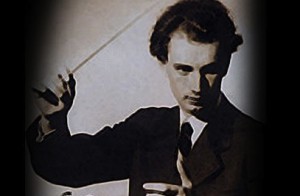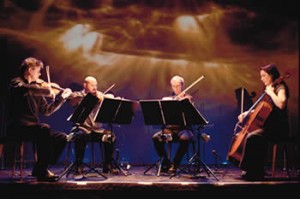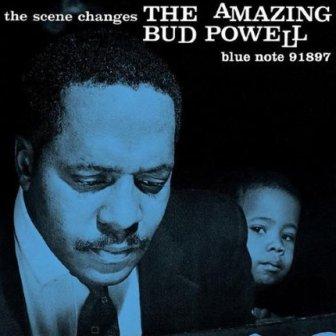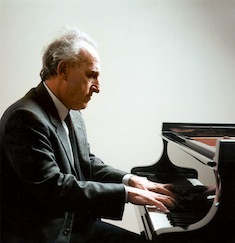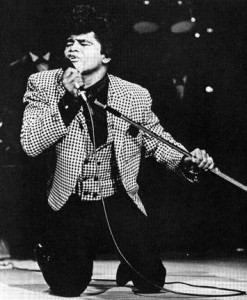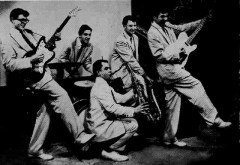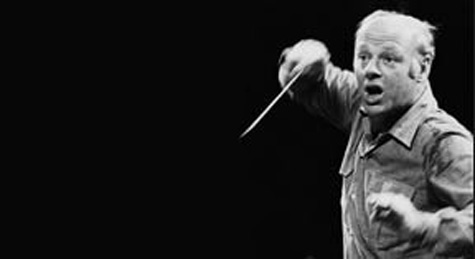Been a busy few days of summer projects (lots of painting!) while also working on some fun SuperCollider and iPad stuff. And some good running. I did continue working on the Kronos Quartet box set, but also brought Mira down for a pick the other night. ‘What should we take Mira?’… ‘A big one daddy!’ … well, there aren’t too many big ones left. Some Miles Davis, lots of opera (which escapes her view for some reason) and a couple other collections here and there, but she pointed at a box set of Dvorak symphonies conducted by Rafael Kubelik. Some great performances on those discs… Kubelik is one of my favorite. He seems to me to be often overlooked, as there were so many great conductors alive during his conducting years. I think his Dvorak recordings are probably one of the best. While I don’t find his Beethoven or Mozart that exciting, I think he really had a knack with late Romantic repertoire. His Mahler recordings are probably one of the best (though I was never able to find all of them on CD… I have them on LP, perhaps it is time to see if I can find them anywhere online… a box WAS released in 2000! … hmmm… maybe I better finish ripping the Mahler discs I DO have before I think about buying anything else).
Day 125. Kronos Quartet.
Posted on Monday, July 12th, 2010 at 10:58 pm in Classical by joshTonight’s choices were motivated more by something I wanted to listen to then anything else. For some reason I got the song “You’ve Stolen My Heart” in my head today (the original title is “Chura Liya Hai Tum Ne”). It is on a disc of music by Bollywood composer R.D. Burman that the Kronos Quartet put together with Burman’s wife, the amazing Asha Bhosle (possibly the most recorded voice in history with well over 12,000 recordings). And since that disc was next to other Kronos Quartet discs I grabbed those as well. Included there was ‘Howl U.S.A.’ (which isn’t as good as I hoped) and the 25 Years box set (which was as good as I hoped).
I have a strange relationship to the Kronos Quartet. On the one hand, what they have done for contemporary music is pretty amazing, even if I sometimes don’t agree with what they choose to perform. Actually, I usually don’t like what they choose to perform. They are amazing players and musicians though, and they have shown how music modern music can and should be performed, and they at times make risky programming choices like a new music ensemble should. The problem is, I’ve always felt like they have a ‘too cool for me’ vibe. And I do mean me personally. Like it isn’t a club I can be part of. I think much of this has to do with how record companies market them (even after thirty years, there is the edgier then anyone else feel to their releases). Like they know what cool is, and they are ‘letting’ us in on it… And I just realized what it is… they are like annoying record store geeks. In other words, what I hate about them the most is probably the part that makes them like me in some ways. ergh… not sure what I think about that (but then again, I’m a little tired… I’ll go over that thought more tomorrow).
Anyways – the Asha Bhosle disc is wonderful. But the 25 year set is a pretty special set of discs to me. The manager at the Tower in Berkeley when I left to move to Seattle (Jim) gave it to me on my last day as a going away present. He knew that I was hoping to go study music and composition (he studied composition as well at college on the east coast), and he thought that he should send me off with good music to learn from as well as enjoy. Jim and I pretty much always got along really well, but him giving me that set caught me off guard, and it really meant a lot to me. I have some of the Arvo Pärt on right now… music that at the time I thought was simplistic and empty. When I moved to Seattle, I couldn’t stand Arvo Pärt, mostly because so many New Agey people bought him. But when I heard the music on these Kronos discs, it started what has been well over a decade of getting to know his music. One of the first things I remember learning while listening to this is that music that sounds ‘easy’ or ‘simple’ is often everything but. Music that is written simply doesn’t last well. Music that sounds easy (or effortless) often takes work, and lots of it. As a result of this realization, it may not be too much of a stretch to say that these discs (which also include Astor Piazzolla, Morton Feldman, Steve Reich and Philip Glass among many others) showed me how much work composing was going to be. It was music that for some reason I didn’t take very seriously until this set was given to me. But Jim giving it to me carried some weight, and I realize now how seriously I took it.
Day 124. Stevie Wonder.
Posted on Sunday, July 11th, 2010 at 9:49 pm in Rock / Pop by joshI grabbed Stevie Wonder’s ‘At The Close Of The Century’ tonight, a four disc set that came out, well, at the close of the last century. I don’t think I quite realized that these discs were ten years old until tonight. Then I thought ‘what has Stevie Wonder done in the past ten years? I know he has paid for Pres. Obama, but other then that, I couldn’t think of anything. Then I wondered what radio station would play any new Stevie Wonder. Of course it isn’t like I listen to much radio but I suddenly started wondering what is going on with Stevie Wonder and, if he put something out today, would it be 1970s Stevie Wonder or 1980’s or??? Of course, Stevie Wonder was never really an innovator. His work in the 70’s was great, but it was what a lot of people were doing in the 70’s. He was just doing it really well. Same with what Little Stevie Wonder was doing in the 60’s. In the 80’s he wasn’t innovating necessarily (though the vocoder solo in ‘I Just Called To Say I Love You’ could be seen as a bit cutting edge at the time, it just sounded like a soft-rock version of ‘Frampton Comes Alive’). Though I am sure a number of people like what Stevie Wonder did from the 80’s on, but I don’t think Barry’s joke in High Fidelity is too far off: “Rob, top five musical crimes perpetuated by Stevie Wonder in the ’80s and ’90s. Go. Sub-question: is it in fact unfair to criticize a formerly great artist for his latter day sins, is it better to burn out or fade away?”
Growing up, I heard more of 1980s Stevie Wonder then I did 1960s or 70s. It wasn’t until I was at a friends house in Berkeley that I heard ‘Talking Book’, ‘Innervisions’ and ‘Songs In The Key Of Life’. It was really the first time I heard classic Stevie Wonder and heard it at a loud volume. I didn’t go to many parties, and never really did, but hearing Stevie Wonder played at this volume in a house full of people still strikes me as making lots of sense. Not that it was raucous or anything. It was a mellow party of people just sitting around listening to music at a loud volume. ‘Superstition’ is a great song to hear sitting around with a bunch of people. But so is ‘I Believe’ and ‘Visions’. Tamiko loves Stevie Wonder as well. When I brought it up tonight to play a bit, Celia didn’t look too interested (after all, the box doesn’t look THAT interesting, especially to a five year old). But once ‘Master Blaster’ came on, both her a Mira perked up and started dancing a bit. Of course, Tamiko was trying to get them to eat their dinner and it was a bit distracting. But I think both of us enjoyed seeing the two of them dancing to Stevie. Going back to Barry’s question from High Fidelity, I came up with one of my own: “If I play 1970s Stevie Wonder for my children, am I in any way obligated to continue the musical exposure to include those later day sins?”. I’m not going to worry too much about that right now… for now we’ll just put on music to enjoy along with a hot July.
Day 123. Bud Powell.
Posted on Friday, July 9th, 2010 at 10:19 pm in Jazz by joshWhile the blog posts have slowed down, the ripping hasn’t. But as I dig more and more into the back shelves as well as a number of discs that I have picked up to fill out parts of a collection (for instance, my Idil Biret Chopin discs which are quite good but don’t really hold a special place in my mind) I was finding that I just wasn’t that into writing about everything. Not that the choice discs in my collection have been exhausted – there are still quite a few left. But since most of those were on the visible part of my shelves, it stands to reason that fewer and fewer of those discs are left. I still want to rip them all, just don’t feel a want to talk about all of them.
So there has been some Chopin this week, some more Faure and finally some Bud Powell. In terms of listening to jazz, I came to Bud Powell kind of late. Mostly because I was usually more drawn to horn players. But within the last five years or so, the pianists I have finally gotten around to listening to (Bud Powell, Andrew Bird and Mal Waldron for example) have all given me a much deeper appreciation for the piano in jazz. Though it is not as though I didn’t have some appreciation before. It’s just that it was always in the context of other players. I came to Red Garland and McCoy Tyner through John Coltrane, and I like Nat King Cole’s piano playing, but you really pay attention to his singing. I did start listening to Thelonious Monk pretty early on, and since I really liked him, if I wanted to put on some jazz piano I would put on Monk. So much jazz piano seemed to take the idea of playing as fast as possible (Dizzy Gillespie once said bop was his way to play music so fast that no one else could keep up) didn’t quite fare as well on piano. On trumpet or saxophone playing a single line as fast as possible works well. On piano it can (and often did) become cacophonous. So finding piano players that did play impressively fast bop yet seemed to really focus so much on a melodic line was, for some reason, a surprise. It really shouldn’t have been… but I still remember putting on my first Bud Powell disc and being surprised how melodic his music was. And how interesting the chord voicings were. Most of all, it seemed like there was an aspect of bop I had never noticed, and I was hooked all over again.
And the funny thing is, it was an album cover that made me pick up my first Bud Powell disc (shown above). First – it is a classic Blue Note cover, wonderful filtered pic of the artist. But it is the kid looking over his shoulder that really caught me. The album was recorded later in Bud’s career, when medication for schizophrenia (after a couple of mental hospital stays) has started to slow his playing down. The title of the album (“The Scene Changes”) hints a bit at the poetics of the cover. He knows he is the old guy, and that the younger ones are coming in. There is still a respect for him of course, but he knows that he is on his way out, and it is important that he passes whatever he can on to the younger generation. Blue Note has so many great covers from this period, but I think this one may be the most beautiful one they ever did.
Day 122. Faure and Tchaikovsky.
Posted on Monday, July 5th, 2010 at 11:02 pm in Classical, Tamiko by josh“Why did Tchaikovsky only write three symphonies? And why did he start numbering them at 4?”. I don’t know why Tchaikovsky’s first three symphonies get such little notice. Number two is quite good actually, and while one and three aren’t the sixth symphony, they aren’t that bad either. I imagine part of the reason is because he has so much good orchestral music that ins’t the first three symphonies that they just get skipped over. Plus, 4-6 fit neatly onto two discs. Kind of a ‘Tchaikovsky’s Greatest Symphony Hits’ of sorts. So – there are lots of collections of 4-6, and tonight I am ripping one of them (the Karajan / Berlin two disc set on DG). Also up for tonight are a stack of discs of Faure piano music, including a Pascal Roge disc that goes back to Tamiko’s apartment on Arch St. (so – more memories of open windows letting in Bay Area fog with piano music on in the background).
There actually aren’t too many discs that fit into this category by the way. For one, I had at this point in life, very little money to spend on CDs. I was paying for community college at the time, and had just moved to Berkeley and was renting a room in a house (that mostly just stored my stuff since I was mostly staying at Tamiko’s). Also, at the time I had a CD rack that held only 240 CDs, so that was pretty much all I owned, and most of those were on the rack in the room I rented. So when I come across the ones that did make it to her place, they stick out pretty clearly. At the time, I was working at the Tower in Concord (often until about 1 in the morning) and getting to her place probably around 1:30 or so. Tamiko was often still up doing homework, and we would put something quieter on to wind down for the night. Now that I think about it, we were usually up until 2 or 2:30 pretty regularly that first year I lived down there, and we would be up by 8am or so for 9am classes. Anyways, we had pretty good set of romantic piano music and some jazz to fall asleep to, and at the moment I’m thinking that might be a good thing to revive. Again, nostalgia and music can really go well together. Maybe we even have that old CD player boom box in the garage somewhere … hmm… At least the weather here in Tacoma right now would be co-operating. 60 degrees and some clouds rolling in on a July evening. Almost Bay Area worthy.
The Tchaikovsky recordings, like some other sets I’ve ripped in this project, actually get better because of it. While I still find ways to work the nostalgia of flipping over an LP into my daily conversation, I have never romanticized the notion of changing discs. And while symphonies 4-6 DO fit onto two CDs, they don’t fit nicely. Usually, the fifth symphony is split between disc one and disc two in these situations. While I would NEVER suggest that these should have been put onto three discs (raising costs, use of materials, etc.), I do know that I haven’t listened to the fifth symphony as much as I have listened to the fourth and sixth. I love that this problem is remedied with moving everything onto hard drives. A playlist can be however long you need it to be. Where CDs took us into the 74 minute (then 80 minutes) limit, now the limit is the size of your hard discs. No more need to break up works across discs. Operas can play straight through… and I can listen to Tchaikovsky 4-6 without interruption. Amazing.
While typing this all up, I also decided to try out iSub for Tamiko’s iPod Touch. Looks great. Don’t think we need the old boom box, we’ll try streaming Faure onto the speakers tonight!
Day 121. Górecki, Kanchelli, Gubaidulina and the Couperins.
Posted on Friday, July 2nd, 2010 at 10:26 pm in Classical, Tamiko by joshStill a busy couple of days that included the completion of Richard Karpen’s recording for his piece ‘Strandlines’ for guitar and live electronics (which Stefan Östersjö will be releasing in the near future) as well as the release of SuperCollider 3.4 (which is uploading to Sourceforge as I type… for some reason, releases and their uploading to SF take a VERY long time, and with the release there are 8 packages to upload). So, while those finish I’ll briefly mention what was ripped last night and tonight.
A good amount of French baroque music, mostly harpsichord works by François and Louis Couperin (with a few smaller chamber works thrown in as well) and tonight a stack of CDs featuring Henryk Górecki, Giya Kancheli and Sofia Gubaidulina. I have the Kronos Quartet recording of Górecki’s third string quartet on right now, and like so much of his music I really like how slowly ideas develop and unfold. And it often has a bit of a romantic intense feeling as well that I think he pulls off. However, the build up in the first movement just disturbed a napping Tamiko, so I will take that as a cue to move on. I don’t blame her. Not happy night time music. I won’t move on to his thrid symphony either (the recording on Naxos which, as much as the Dawn Upshaw recording is ‘the favored’ version, I really thing this one is much better).
Should start having more time again to write more soon. I’m looking forward to things slowing down a little at some point soon!
Day 120. Beethoven and Marais.
Posted on Wednesday, June 30th, 2010 at 11:26 pm in Celia, Classical by joshI’ve had little time to properly rip some discs the past couple of days. Busy working on finishing up a recording project, and today was also Celia’s 5th birthday. We started the morning out with ‘Birthday’ by The Beatles (don’t think she would like the Sugarcubes as much yet, though I might be surprised). I’ve also been making sure to keep up on some exercise, and I will be releasing a small piece of software soon that accesses your iTunes library, and let’s you make mixes that are keyed to your running pattern. I’ve been running / walking to Led Zeppelin the past couple weeks, and for the most part it works nicely. Though some tunes a poor choices in hindsight. ‘Achille’s Last Stand’ is fine for running AFTER the first 40 seconds of fade in droning guitar. ‘When The Levee Breaks’ = worst running song ever??? But the best cool down song is five minutes of walking home to ‘The Lemon Song’ and playing air bass.
So I went ahead and added some purchases from the past couple of months tonight. These included a couple discs of music for viols by Marin Marais and Pollini and Abbado’s set of Beethoven piano concertos. The Marais is wonderful music, and can sound quite different to ears that haven’t heard much viol music. The viol (viola da gamba and friends) has a more nasally sound, not quite as resonant as the cello. It also is a little slower to speak. Much of the music also tends to have longer, more sweeping lines (this is a generality I probably shouldn’t make, but I think most people who have heard music for viols would probably agree with me that this is the music it played best), and can be very lyrical and emotional. One of this discs though is a set of suites, and some of it really moves. Some of the articulations (which even survived in French music to the present day) are quite snappy, even surprising after hearing such long drawn out attacks in slower movements.
The Pollini set was a big surprise to me. I don’t dislike his solo Beethoven sonata recordings, but don’t really like them much either. Mostly, I was indifferent about them. But the concerto recordings were done close to 20 years after the other recordings, and as a pianist Pollini has grown amazingly. He may be one of the best living pianists today. And Abbado, as he was nearing the end of his time with Berlin, had also grown and learned probably as much from working with such an amazing orchestra as they learned from him. These recordings are wonderful pretty much all around. I’m going to throw on the fourth concerto right now I think before I go to bed… or maybe the middle movement of the ‘Emperor’. Either way, I know it will be a good way to end the night.
Day 119. Wild and Wooly, Funk Blast! and I.R.S. Records ‘On The Charts’.
Posted on Monday, June 28th, 2010 at 9:58 pm in Rock / Pop, Tamiko by joshGrabbed a few collections tonight, two that came out from the Experience Music Project here in Seattle, and a demo disc that I.R.S. Records put out in 1994 to celebrate 15 years of ‘being on the charts’.
The EMP discs I got with some weariness. EMP represents to me most of what I think is wrong in the world. It is an expensive ‘museum’ of Paul Allen’s memorabilia collection that is a headphone / PDA guided tour of, well, Paul Allen’s stuff. And the building is the biggest architectural disaster of Frank Gehry. I love his work usually, but this monstrosity is just hideous. And to top it off, when you go to the top of the space needle and look DOWN on it, the roof has had no design attention paid to it. No, if I was putting a building, especially one that is supposed to be interesting to look at, next to the Space Needle, what would I make sure to do? I would make sure it looked damn good from above. Anyways, the aesthetic problems, as well as the audacity that Paul Allen has to basically put his money into building a museum to store the stuff he has bought, then to charge an arm and a leg to close yourself off to the museum experience tells me that there would probably be problems with mix discs that the same place produced. The surprise is, they are actually pretty good. There are some small problems here and there, but they are, for the most part, pretty right on.
One set is a chronology of rock in the northwest called ‘Wild and Wooly’, and charts 50s garage bands up to Murder City Devils. The Wailers and The Kingsmen are represented, as is Mudhoney’s ‘Touch Me I’m Sick!’, a pre-Nevermind Nirvana track, Sleater-Kinney and some power pop from The Posies. My favorite moment on the disc though happens near the beginning of disc 2… Queenryche leads into Green River (followed by a torrent of grunge). It is almost like a baton is passed, and the music of the ‘90s takes over. The second set called ‘Funk Blast!’, and it earns my ultimate respect for starting out with not one but TWO James Brown songs. THEN it goes onto The Temptations’ ‘Papa Was A Rolling Stone’. Pretty bad-ass way to start a funk chronology. War gets a track, Funkadelic, Chic, Ohio Players, Parliament… most of what you expect. But once it starts, the two discs are playable pretty much from start to finish. This set may be one of Tamiko’s top 10 most played discs actually. Pretty solid set… especially considering the EMP sins discussed above.
The I.R.S. disc is fun as well, though definitely something meant for in-store play as a way to sell older re-issues. It did get me ‘Mexican Radio’ and ‘The Future’s So Bright’ though without needing to buy discs by Wall of Voodoo and Timbuk 3.
Day 118. Brahms.
Posted on Saturday, June 26th, 2010 at 10:34 pm in Classical by joshOne of my favorite quotes about Brahms’ fourth symphony comes from Ravel. I can’t remember it exactly, but a friend of Ravel’s asks if he is going to go to a performance, and Ravel says something like ‘why would I go listen to that silly waltz?’, his friend says Ravel must be confused, there is no waltz in the fourth symphony. Then Ravel says ‘sure there is’ and starts to sing to melody to the first movement in 3/4 DAAA-da, DAAA-da, DAAA-da etc. etc. Whenever I hear the fourth now, I almost always think of how Ravel must have sung this (probably quite a bit like a couple of his ‘Valses nobles et sentimantales’).
Tonight I ripped the Bernard Haitink box set of the symphonies along with a number of other orchestral works (including both serenades!). The box is part of a set of boxes covering most of the romantic and some classical symphonic repertoire that Phillips put out featuring Haitink and the Concertgebouw of Amsterdam. Most were done in the ‘70s, and they pulled together complete sets of Brahms, Schumann, Mahler, Beethoven and others. Many of these recordings now show up as budget discs, and as a result they are often overlooked, but they are wonderful performances. Haitink is such a great musician and conductor, and paired with one of the best orchestras in the world in a wonderful concert hall, it is hard to go wrong. The boxes are hard to find now (and I’m still searching for the Mahler and Bruckner sets), but many of these sets can be pieced together as single discs and double-disc sets. Not a bad way to build up a good overview of symphonic literature!
Day 117. Buxtehude (and finally getting around to Beethoven and Bach)
Posted on Friday, June 25th, 2010 at 9:58 pm in Classical by joshNot much time for ripping CDs tonight (still catching up from the other night actually), so I am throwing onto the computer a couple of collections I have purchased over the past year. They are two (that’s right, two) COMPLETE sets of the organ work of Buxtehude. Why two? A couple reasons… first, they are both played quite well (Rene Saorgin and Ulrik Spang-Hanssen are the two players) and one of the fun things about organ music is how different performances can be just based on tone color. Organists often prepare pieces with their own choices for stops, and one thing I like to do is hear the same piece played by two different players to see what they do with it. And if that isn’t geeky enough, I also like to hear what different organs sound like. More then just about any other instrument, the organ can be likened to modern day astronomy. When you look at stars, you are seeing what they looked like in the past, and with organs, you get one of the few instruments that really holds their original quality. You can get a sense of how different areas used different tuning systems, and you also get an instrument that, more then any other, needs an entire building as its resonating body. So there can be big differences between performances and recordings.
Of course, some of the same things can be said about just about any recording of classical music. And if you start to throw in jazz standards, live rock recordings and covers, it really can be said about all music. Music can and should be performed by many people many times. It was always a little disheartening to me when people would come in and ask for ‘the best recording of blah blah blah’. There is no best recording, but here… take five recordings and see if you can figure out what it is about a piece that makes it what it is. It’s hard in some ways, but very fun as well. I completely understand the want for the best recording of something though, especially if you are just starting to explore a genre and want to get the best impression possible. Plus, the whole endeavor is expensive. I was very fortunate to be in a situation where I was given a large part of my collection, and the parts I did have to buy were discounted. But for the customer wanting just ‘the best’, I’m not really sure if such things exist. What I do know is that whatever recording you hear first, for the most part that is how you will learn most of a piece, and you will judge all other recordings and performances based on those impressions (so in some ways get any version, and for the time being you will think it is the best version of the piece around).
Now – getting a group of people together who do know a work and multiple versions of it is lots of fun… there is argument and agreement, and the quibbling over details small and large. And these kinds of conversations really made up usually about a quarter of any given shift working in the classical room at Tower in Berkeley (where there were usually a few customers who came in for an hour here and there throughout the week). They were a blast. And I learned a lot about music this way. I learned a lot about what people listen for, and in turn what I could or should listen for. It was some of the best ear training I had while earning my music degree, and it certainly shaped how I think as a composer.
If you have been reading my entries here and there, the idea of two complete Buxtehude sets probably isn’t really that far-fetched. Especially considering that I also ripped my third (of five I think?) set of Beethoven symphonies as well (the John Eliot Gardiner set) and Anner Bylsma’s second set of Bach cello suites (on Sony). I think I have six versions of the cello suites – and on top of that, I know at least two of those are by Anner Bylsma! It fun to hear the differences between the two Bylsma sets (surprising even!) but if you are familiar with Beethoven’s symphonies and haven’t heard Gardiner’s recordings, I really recommend you grab at least one of them to listen to. The fifth will sound like a new piece to you, but if I had to choose one, I’d say give the third a listen. The playing is extremely precise (a little cold even in parts), but the tempos (very strictly the ones Beethoven marked down later in life) and the use of period instruments make these sound quite different then the large, romantic orchestral performances that were the norm of the 40s and 50s. In other words, this isn’t your grandfather’s Klemperer or Furtwangler. And while in some ways, these period instrument recordings would seem to owe quite a bit to the early 19th century, they are also the product of musicians who have probably seen more then their share of modern scores. Dynamic range seems a bit exaggerated at times, but it works very well with this music. In some ways, it took a group playing instruments that are two hundred years old to make Beethoven sound new again, and overall the results are great fun. I just wouldn’t recommend them to someone as the first set of symphonies to hear.


